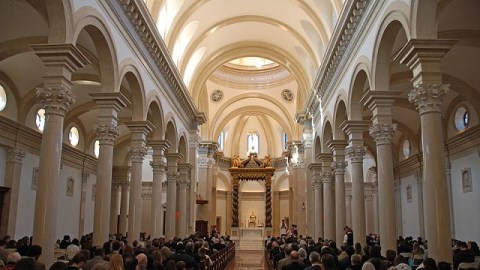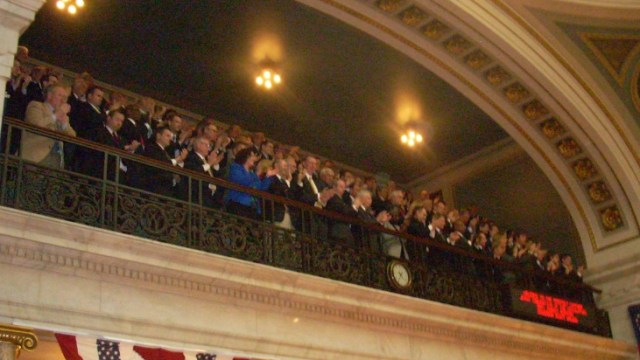Church Going: How to Read Churches

“Once I am sure there’s nothing going on/ I step inside, letting the door thud shut,” begins Philip Larkin’s poem “Church Going.” “Another church: matting, seats, and stone,/ And little books; sprawlings of flowers, cut/ For Sunday, brownish now; some brass and stuff/ Up at the holy end.” For many of us, walking into a church we dumbly look at the “holy end” and wish we knew to call it the sanctuary, with all the connotations that word holds. Denis R. McNamara’s How to Read Churches: A Crash Course in Ecclesiastical Architecture gives us those words as well as their deeper meanings. With Lent and Easter just around the corner for Christians, McNamara’s book provides the perfect entry, or re-entry, for those going to church hoping to find the significance of the glass and stone earlier generations understood and found comfort in.
“The first century BCE architect Vitruvius wrote that all buildings have two components,” McNamara writes in his introduction, “the building itself and an idea that its architect tried to express. This is especially true for churches.” Throughout his book, McNamara gives all the names and definitions, but adds the spiritual dimension that drove artists and artisans to turn acts of faith into concrete realities. Although conscious of this higher calling, McNamara never loses sight of the practical issues of a modern visitor confronted with an ancient grammar of symbols. The book itself is conveniently pocket-sized and light enough to carry through a full day of sightseeing. McNamara reduces mammoth religious structures to understandable fragments, which he then concisely introduces and explains using both text and line drawings of the element discussed, sometimes taken from famous churches around the world.
But what if you don’t care if that buttress is flying or not? Maybe you don’t know your apse from a hole in the ground, and it’s never held you back. Reading a church is the reading of past forms of believing and thinking, many of which are largely lost. Opening yourself up to McNamara’s world of churches shows you just how much we’ve lost in terms of thinking and, perhaps, believing. Writing about geometric ornamentation, McNamara explains that “[m]athematics and geometry were understood as ways to return order and right proportions to the chaos of a fallen world.” “Geometric ornament based on repeating patterns gave a dynamic and ordered overlay to church buildings,” he continues, “while respecting ornamental patterns developed by pre-Christian societies that subsequently accepted Christianity.” Looking at the examples of geometric designs, I couldn’t help but think of the relentless geometry of mosques. Although McNamara concentrates mainly on Christian structures, it’s not a great stretch of the imagination to extend this thinking to the buildings of other faiths and see connections rather than the divisions that, unfortunately, rule our world today.
There’s an addictive quality to the tidbits McNamara neatly attaches to the tiniest architectural detail. To know that the nave comes from the Latin navis or “ship” is to see the area for the congregation as a ship with all the connotations of unity and weathering the storm together. If the mad crush of faces and figures in stained glass windows confounds you, McNamara gives helpful advice on separating the saints from the donors. I’ve seen photos of Russian onion domes countless times, but knowing that they mimic the burning flames of candles and usually appear in fives (one for Jesus Christ and four for the Four Evangelists) made me see them with fresh eyes. Armed with all these factoids you can easily become an amateur ecclesiastical sleuth recognizing when fires, iconoclasm, or other events changed the design of a church in one direction or another. (Scrabble devotees will appreciate learning words like squinch just for the love of language.)
What separated McNamara’s book for me from other guides is the expansiveness of his scope. He gives all the pagan origins for many church elements and even explains how non-Christian influences found their way into churches, but he also looks to modern and even post-modern church architecture, giving equal respect to Notre Dame de Paris and Le Corbusier’s Notre Dame du Haut. Duncan Stroik‘s Thomas Aquinas College Chapel in Santa Paula, California (shown above), with its “unapologetic use of Classical precedent” and use of “Early Christian, Renaissance, baroque, and Spanish Mission modes,” perfectly embodies the post-modern, “back to the future” approach of much of today’s best religious architecture.
At the end of “Church Going,” Larkin decides “the place was not worth stopping for./ Yet stop I did: in fact I often do,/ And always end much at a loss like this,/ Wondering what to look for; wondering, too,/ When churches will fall completely out of use/ What we shall turn them into.” Even if you are not a believer, McNamara’s How to Read Churches will make you wonder what we shall turn these monuments of the past into for us today—meaningless ruins or emblems of a passion and hope that we can, and should, recognize and incorporate into our lives.
[Image: Interior of Thomas Aquinas College Chapel in Santa Paula, California, designed by architect Duncan Stroik. Image source here.]
[Many thanks to Rizzoli for providing me with a review copy of How to Read Churches: A Crash Course in Ecclesiastical Architecture by Denis R. McNamara.]





